Related Research Articles
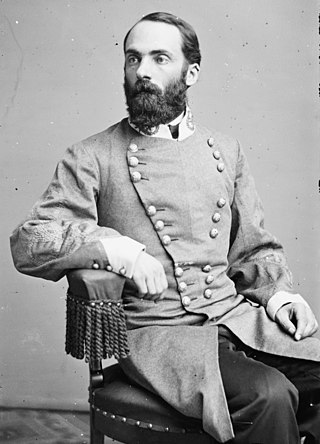
Joseph "Fighting Joe" Wheeler was a military commander and politician of the Confederate States of America. He was a cavalry general in the Confederate States Army in the 1860s during the American Civil War, and then a general in the United States Army during both the Spanish-American and Philippine–American Wars near the turn of the twentieth century. For much of the Civil War, he was the senior cavalry general in the Army of Tennessee and fought in most of its battles in the Western Theater.
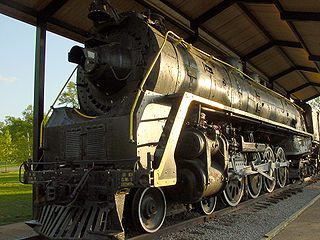
The Nashville, Chattanooga and St. Louis Railway was a railway company that operated in the U.S. states of Kentucky, Tennessee, Alabama, and Georgia. It began as the Nashville and Chattanooga Railroad, chartered in Nashville on December 11, 1845, built to 5 ft gauge and was the first railway to operate in the state of Tennessee. By the turn of the twentieth century, the NC&StL grew into one of the most important railway systems in the southern United States.

The Central of Georgia Railway started as the Central Rail Road and Canal Company in 1833. As a way to better attract investment capital, the railroad changed its name to Central Rail Road and Banking Company of Georgia. This railroad was constructed to join the Macon and Western Railroad at Macon, Georgia, in the United States, and run to Savannah. This created a rail link from Chattanooga, on the Tennessee River, to seaports on the Atlantic Ocean. It took from 1837 to 1843 to build the railroad from Savannah to the eastern bank of the Ocmulgee River at Macon; a bridge into the city was not built until 1851.
Stuart R. Knott was the fourth president of Kansas City Southern Railway.

Samuel Morse Felton Jr. was an American railroad executive.

Samuel Davis McReynolds was an American politician and judge who served as a member of the United States House of Representatives for the 3rd congressional district of Tennessee.

George A. Ellsworth, commonly known as "Lightning" Ellsworth, was a Canadian telegrapher who served in the cavalry forces of Brig. Gen. John Hunt Morgan in the Confederate Army during the American Civil War. His use of the telegraph to spread disinformation to the Union forces was declared by The Times as the greatest innovation to come out of the war.
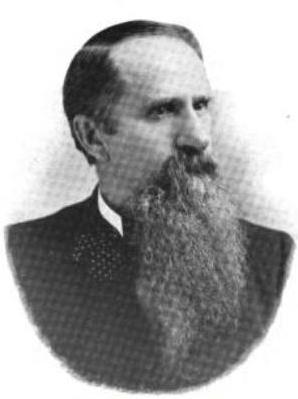
William Henderson Cate was an American politician, lawyer and judge. In 1889 and 1890, he served part of one term as a U.S. Representative from Arkansas. He was removed from his seat following an investigation of election fraud before regaining the seat in the subsequent election, serving an additional term from 1891 to 1893.

The Coal Creek War was an early 1890s armed labor uprising in the southeastern United States that took place primarily in Anderson County, Tennessee. This labor conflict ignited during 1891 when coal mine owners in the Coal Creek watershed began to remove and replace their company-employed, private coal miners then on the payroll with convict laborers leased out by the Tennessee state prison system.
The Southern League was a Class B and Class C minor league baseball league which operated intermittently in the Southern United States from 1885 to 1899. Financial problems plagued the league and its member teams throughout their existence. It was not unusual for teams to depart the league during the season or for the league to cease operations without completing the season. It was this lack of financial support which ultimately caused the league to permanently disband in 1889. In 1901, a new league, called the Southern Association, was created from its remnants.
Daniel Coffee Trewhitt was an American attorney, judge, and politician. He served one term (1859–1861) in the Tennessee House of Representatives, where he was one of the few state legislators to oppose secession on the eve of the Civil War. He represented Hamilton County at the pro-Union East Tennessee Convention, and afterward fought for the Union Army. He served as judge of the state's second chancery division from 1864 to 1870, and judge of the state's fourth circuit court from 1878 to 1891.
J. Washington Moore was an American fraternity president, lawyer and politician. He served as the Eminent Supreme Archon (President) of Sigma Alpha Epsilon from 1891 to 1894. He was a member of the Tennessee House of Representatives in 1903. He served as the City Attorney for Nashville, Tennessee in the 1930s. He served as United States Commissioner from 1942 to 1963.

Samuel R. Lowery was an African American preacher and lawyer, who was the first black lawyer to argue a case before the Supreme Court of the United States of America. Lowery was sponsored to the Supreme Court Bar by Belva Ann Lockwood, the first woman admitted to the bar, in 1880. Lowery was the fifth black attorney to be admitted to the bar. Later in his life, he worked for African American industrial education and attempted to establish silk farming in Alabama.
John W. Stevenson was an African Methodist Episcopal (AME) Church minister. He was the financier and builder of the Metropolitan African Methodist Episcopal Church in Washington, DC, which was the largest black church in the country at the time of its building. He was a talented fundraiser and built a number of other churches and was pastor of many churches in Maryland, New Jersey, Pennsylvania, New York, and New England. He was an important figure in the church and eventually held the position of presiding Elder of the New York district.
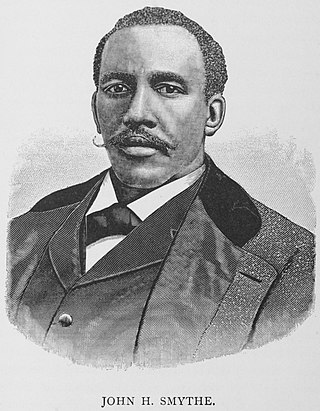
John H. Smythe was the United States ambassador to Liberia from 1878 to 1881 and from 1882 to 1885. Before his appointment, he had various clerkships in the federal government in Washington, DC, and in Wilmington, North Carolina. Later in his life he took part in a number of leading African American organizations and was president of a Reformatory School outside of Richmond, Virginia.
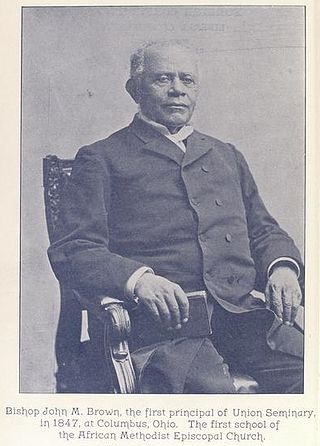
John Mifflin Brown was a bishop in the African Methodist Episcopal (AME) Church. He was a leader in the underground railroad. He helped open a number of churches and schools, including the Payne Institute which became Allen University in Columbia, South Carolina, and Paul Quinn College in Waco, Texas. He was also an early principal of Union Seminary which became Wilberforce University.

Irvine Garland Penn was an American educator, journalist, and lay leader in the Methodist Episcopal Church. He was the author of The Afro-American Press and Its Editors, published in 1891, and a coauthor with Frederick Douglass, Ida B. Wells, and Ferdinand Lee Barnett of The Reason Why the Colored American Is Not in the World's Columbia Exposition in 1893. In the late 1890s, he became an officer in the Methodist Episcopal Church and played an important role advocating for the interests of African Americans in the church until his death.
Colonel Edmund William Cole was an American Confederate veteran and businessman. He was the president of the Nashville, Chattanooga and St. Louis Railway, and the founder of the American National Bank.
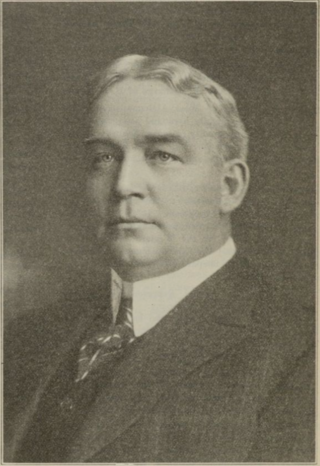
Whiteford Russell Cole was an American businessman. He was the president of the Louisville and Nashville Railroad from 1926 to 1934, and a director of many companies. During the railroad strike actions of 1921–1922, he threatened his workers with dismissal and loss of pensions. His mansion in Louisville, Kentucky, is the official residence of the president of the University of Louisville.
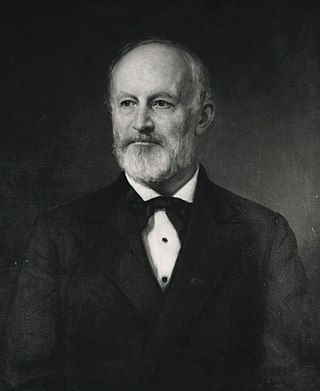
Vernon K. Stevenson was an American businessman. He served as the president of the Nashville and Chattanooga Railway for 25 years, and as the president of the Southern Pacific Railroad. He was a real estate investor in Manhattan, New York City.
References
- 1 2 3 Simmons, William J., and Henry McNeal Turner. Men of Mark: Eminent, Progressive and Rising. GM Rewell & Company, 1887. p995-1002
- ↑ Lester, Connie L. Up from the mudsills of hell: the Farmers' Alliance, populism, and progressive agriculture in Tennessee, 1870–1915. University of Georgia Press, 2006. p133
- ↑ Serious Accident and Narrow Escape, The Wilmington Messenger (Wilmington, North Carolina) August 22, 1888, page 1. Retrieved January 18, 2017 at https://www.newspapers.com/clip/8432617//
- ↑ Unbalanced Books, The Courier-Journal (Louisville, Kentucky) October 28, 1890, page 5. Retrieved January 18, 2017 at https://www.newspapers.com/clip/8432674/unbalanced_books_the_courierjournal/
- ↑ Victory Assured, The Tennessean (Nashville, Tennessee) September 17, 1891, page 6. Retrieved January 18, 2017 at https://www.newspapers.com/clip/8432723/victory_assured_the_tennessean/
- ↑ For a Negro Colony, The Baltimore Sun, (Baltimore, Maryland) January 16, 1899, page 2. Retrieved January 18, 2017 at https://www.newspapers.com/clip/8432769/for_a_negro_colony_the_baltimore_sun/